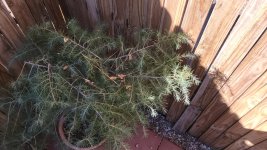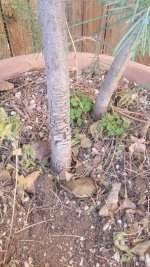RJW
Seedling
I received this tree today from someone in my local bonsai club. It was given to them years ago by someone who dug it up out of the ground. They were originally told it was a larch but it is obviously an evergreen which leads me to believe it is a Cedrus deodara. I'm going to start working on root reduction in the spring. As of today my plan for this twin trunk is to remove/ jin the bulk of the lower branches & work with the upper canopy's weeping habit. Tomorrow I will inspect the soil some to see if there is some hidden nebari going on. The texture showing up on the trunk is very promising though. This might be the oldest tree in my collection so far. My small amount of research on this species has revealed some problems but my location in Albuquerque, NM solves many of them right off the bat. Would love to get some recommendations, suggestions, & even opinions to consider before spring gets here.
Thanks,
Thanks,












